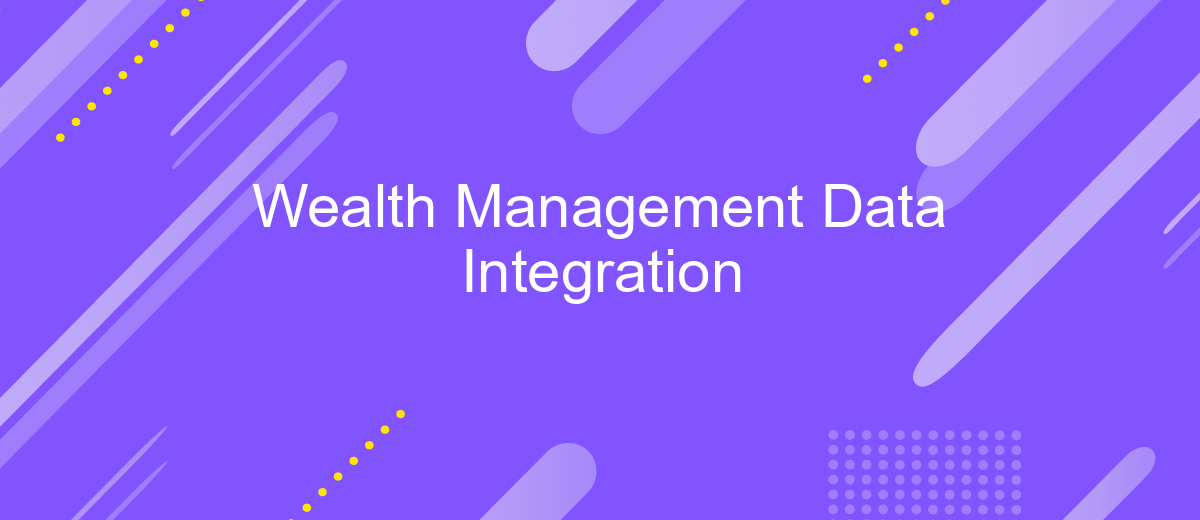Wealth Management Data Integration
In today's rapidly evolving financial landscape, wealth management firms face the challenge of efficiently integrating diverse data sources to provide comprehensive and personalized client services. Effective data integration not only enhances decision-making but also ensures regulatory compliance and operational efficiency. This article explores the key strategies and technologies driving successful wealth management data integration, enabling firms to stay competitive and deliver exceptional value to their clients.
Introduction
In the rapidly evolving financial landscape, wealth management firms face increasing pressure to provide personalized and efficient services to their clients. One of the critical components to achieving this goal is the seamless integration of data across various platforms and systems. Effective data integration enables wealth managers to gain comprehensive insights into client portfolios, market trends, and investment opportunities, ultimately enhancing decision-making processes.
- Improved client experience through personalized services
- Enhanced decision-making with comprehensive data insights
- Streamlined operations by reducing manual data entry and errors
- Increased compliance and risk management capabilities
As the demand for more sophisticated financial solutions grows, wealth management firms must invest in robust data integration strategies. By leveraging advanced technologies and best practices, these firms can ensure that they remain competitive in an increasingly data-driven industry. This introduction explores the significance of data integration in wealth management and outlines the key benefits it offers to both firms and their clients.
Data Integration Challenges in Wealth Management

Data integration in wealth management presents numerous challenges, primarily due to the complexity and variety of data sources. Financial advisors must integrate data from multiple platforms, including banking systems, investment portfolios, and market data providers. This process often involves dealing with disparate data formats, inconsistent data quality, and the need for real-time data synchronization. Ensuring data accuracy and consistency across these diverse sources is critical for making informed investment decisions and providing personalized client services.
Moreover, regulatory compliance adds another layer of complexity to data integration in wealth management. Firms must adhere to stringent regulations such as GDPR, MiFID II, and others, which require secure data handling and transparent reporting. Utilizing services like ApiX-Drive can streamline the integration process by automating data transfers between various systems, ensuring data integrity, and reducing manual errors. By leveraging such tools, wealth management firms can enhance operational efficiency, maintain regulatory compliance, and ultimately deliver better outcomes for their clients.
Key Data Sources for Wealth Management

In the realm of wealth management, the integration of diverse data sources is crucial for providing comprehensive financial advice and services. Accurate and timely data allows wealth managers to make informed decisions, manage risks, and tailor strategies to individual client needs. By leveraging various data sources, wealth management firms can gain a holistic view of their clients' financial landscapes.
- Financial Accounts: Information from bank accounts, investment portfolios, and retirement funds provides a baseline for understanding a client's financial status.
- Market Data: Real-time data on stock prices, interest rates, and economic indicators help in assessing market conditions and making investment decisions.
- Client Information: Personal data, including income, expenses, and financial goals, is essential for creating personalized financial plans.
- Regulatory Data: Compliance with legal and regulatory requirements necessitates access to up-to-date regulatory information.
- Third-Party Data: Insights from credit agencies, real estate databases, and other external sources can enhance the accuracy of financial assessments.
Integrating these key data sources enables wealth managers to provide tailored advice, optimize investment strategies, and ensure regulatory compliance. The seamless integration of diverse datasets not only enhances decision-making but also strengthens client relationships by delivering personalized and effective wealth management solutions.
Data Integration Strategies for Wealth Management

In the realm of wealth management, seamless data integration is paramount for delivering comprehensive financial services. Efficient data integration strategies enable firms to unify disparate data sources, ensuring accurate and timely information flow. This not only enhances decision-making but also improves client satisfaction by providing a holistic view of their financial portfolio.
To achieve effective data integration, wealth management firms should adopt a multi-faceted approach. This involves leveraging advanced technologies and best practices to streamline data processes. Key strategies include:
- Utilizing Application Programming Interfaces (APIs) to facilitate real-time data exchange between systems.
- Implementing data warehousing solutions to consolidate data from various sources into a central repository.
- Employing data normalization techniques to ensure consistency and accuracy across datasets.
- Adopting cloud-based platforms for scalable and flexible data integration solutions.
- Ensuring robust data governance and compliance frameworks to maintain data integrity and security.
By integrating these strategies, wealth management firms can achieve a unified data ecosystem. This not only enhances operational efficiency but also empowers advisors with the insights needed to deliver personalized and effective financial guidance to their clients.
- Automate the work of an online store or landing
- Empower through integration
- Don't spend money on programmers and integrators
- Save time by automating routine tasks
Conclusion
Wealth management data integration is crucial for streamlining financial operations, enhancing client experiences, and driving informed decision-making. By consolidating disparate data sources into a unified platform, wealth managers can gain a comprehensive view of their clients' financial landscapes, enabling more personalized and effective advisory services. This integration not only improves operational efficiency but also helps in maintaining regulatory compliance and mitigating risks associated with data silos.
Incorporating advanced integration services like ApiX-Drive can further simplify the process. ApiX-Drive allows seamless connection between various financial tools and platforms, automating data flow and reducing manual intervention. This ensures that wealth managers have real-time access to accurate and up-to-date information, facilitating better client interactions and strategic planning. Ultimately, effective data integration is a cornerstone of modern wealth management, empowering firms to deliver superior value and achieve long-term success.
FAQ
What is Wealth Management Data Integration?
Why is Data Integration important in Wealth Management?
How can I automate the integration of wealth management data?
What are the benefits of using a service like ApiX-Drive for data integration?
Is it difficult to set up data integration for wealth management?
Time is the most valuable resource in today's business realities. By eliminating the routine from work processes, you will get more opportunities to implement the most daring plans and ideas. Choose – you can continue to waste time, money and nerves on inefficient solutions, or you can use ApiX-Drive, automating work processes and achieving results with minimal investment of money, effort and human resources.


